|
|
 |
Fiche d'espèce de Copépode |
|
|
Calanoida ( Ordre ) |
|
|
|
Diaptomoidea ( Superfamille ) |
|
|
|
Candaciidae ( Famille ) |
|
|
|
Candacia ( Genre ) |
|
|
| |
Candacia columbiae Campbell, 1929 (F,M) | |
| | | | | | | Syn.: | C. pacifica Mori, 1937 (1964) (p.87, figs.F); Chiba & al., 1957 a (p.11); Cervantes-Duarte & Hernandez-Trujillo, 1989 (tab.3); Padmavati & al., 1998 (p.347) | | | | Ref.: | | | Campbell, 1929 a (p.317, figs.F,M); Davis, 1949 (p.63, figs.F,M); Brodsky, 1950 (1967) (p.403, figs.F,M); Grice, 1963 (p.175, figs.F,M, Rem.); Arashkevich, 1969 (p.703, fig.14); Shih & al., 1971 (p.146); Minoda, 1971 (p.42, Rem.); Gardner & Szabo, 1982 (p.406, figs.F,M); Chihara & Murano, 1997 (p.752, Pl.74,77: F,M); Vaupel Klein, 1998 (p.443, fig.M); Sedova, 2008 (p.1, figs.F,M | 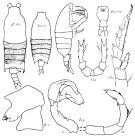 Issued from : K.A. Brodskii in Calanoida of the Far Eastern Seas and Polar Basin of the USSR. Opred. Fauna SSSR, 1950, 35 (Israel Program for Scientific Translations, Jerusalem, 1967) [p.404, Fig.287]. Female (NW Pacif.): habitus (dorsal and lateral right side, with spermatophore); urosome (ventral); S5, P5. Male: habitus (dorsal); S3, P3; S5, P5 (Le = left leg; Ri = right leg). Gs, genital segment (lateral left side). Nota: Thorax pitch black, except the 5th segment. Process of genital segment male with black distal ends
|
 issued from : C.C. Davis in Univ. Wash. Publs Biol., 1949, n. ser. 14. [Pl.13, Figs.162-168]. Female (from NE Pacific): 162, Md (masticatory blade); 164, last two segments of prosome and urosome (dorsal); 165, 3rd exopod segment of P3; 167, P5; Male: 163, last segment of prosome and urosome (dorsal); 166, genital segment and 2nd urosomal segment (dorsal); 168, P5.
|
 issued from : T. Mori in The Pelagic copepoda from the neighbouring waters of Japan, 1937 (1964). [Pl. 59, Figs.6-12]. As Candacia pacifica. Female: 6, Mx2; 7, P1; 8, P3; 9, P2; 10, P5; 11, genital segment (ventral); 12, habitus (dorsal).
|
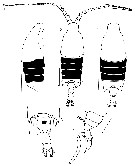 issued from : N.A. Sedova in Zool. Zh., 2008, 87 (11). [p.2, Fig.1]. Female (from Kamchatka Peninsula): 1, cephalothorax (lateral); 2, habitus (dorsal); 3, corners of last thoracic segment and urosome (ventral); 4, last thoracic segments and urosome with spermatophore (lateral). Male: 5, habitus (dorsal). Scale bars: 1 mm (1, 2, 4, 5); 0.5 mm (3).
|
 issued from : N.A. Sedova in Zool. Zh., 2008, 87 (11). [p.4, Fig.2]. Female: 1, proximal segments; 2, A2; 3, Md; 4, Md (gnathobase). Male: 5, A1 (proximal, geniculation and segments ); 6, Md (gnathobase). Scale bars: 0.2 mm (1, 2, 3, 5); 0.1 mm (4, 6).
|
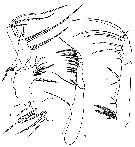 issued from : N.A. Sedova in Zool. Zh., 2008, 87 (11). [p.5, Fig.3]. Female: 1, Mx1; 2, Mx2; 3, Mxp. Male: 4, Mx1. Scale bars: 0.2 mm.
|
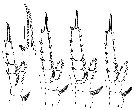 issued from : N.A. Sedova in Zool. Zh., 2008, 87 (11). [p.6, Fig.4]. Female: 1-4, P1 to P4; 5, apical seta with anomaly. Scale bars: 0.3 mm (1-4); 0.1 mm (5).
|
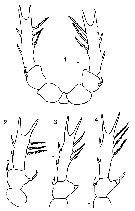 issued from : N.A. Sedova in Zool. Zh., 2008, 87 (11). [p.8, Fig.5]. Female: 1, P5 normal; 2-4, P5 with anomalies. Scale bars: 0.1 mm (1-4).
|
 issued from : N.A. Sedova in Zool. Zh., 2008, 87 (11). [p.8, Fig.5]. Male: 1, right P5; 2, left P5. Scale bars: 0.2 mm (1-2).
| | | | | Ref. compl.: | | | Sewell, 1948 (p.391, 396, 399); Minoda, 1958 (p.253, Table 1, abundance); Vinogradov, 1968 (1970) (p.58, 257); Omori, 1969 (p.5, Table 1); Morris, 1970 (p.2301); Peterson & Miller, 1976 (p.14, Table 1,3, abundance vs interannual variations); 1977 (p.717, Table 1, seasonal occurrence); Gordon & al., 1985 (p.89, Table 2, 3, fish diet); Rudyakov, 1986 (tab.1); Mackas & Anderson, 1986 (p.115, Table 2); Coyle & al., 1990 (p.763); Shih & Marhue, 1991 (tab.2, 3); Hattori, 1991 (tab.1, Appendix); Shih & Young, 1995 (p.69); Kotani & al., 1996 (tab.2); Suarez-Morales & Gasca, 1998 a (p108); Dolganova & al., 1999 (p.13, tab.1); Pinchuk & Paul, 2000 (p.4, table 1, % occurrence); Yamaguchi & al., 2002 (p.1007, tab.1); Lan & al., 2004 (p.332, tab.1); Park, W & al., 2004 (p.464, tab.1); Sedova & Grigoriev, 2005 (p.112); Ikeda & al., 2006 (p.1791, Table 2); Galbraith, 2009 (pers. comm.); Homma & Yamaguchi, 2010 (p.965, Table 2); Homma & al., 2011 (p.29, Table 2, 3, abundance); Batten & Walne, 2011 (p.1643, Table I, abundance vs temperature interannual variability); Takenaka & al., 2012 (p.1669, fig.2, 3, Table 1, bioluminescence); in CalCOFI regional list (MDO, Nov. 2013; M. Ohman, pers. comm.); Ohashi & al., 2013 (p.44, Table 1, Rem.); Coyle & al., 2014 (p.97, table 3); Chiba S. & al., 2015 (p.968, Table 1: length vs climate) | | | | NZ: | 6 | | |
|
Carte de distribution de Candacia columbiae par zones géographiques
|
| | | | | | | | |  issued from : N.A. Sedova in Zool. Zh., 2008, 87 (11). [p.9, Fig.6]. issued from : N.A. Sedova in Zool. Zh., 2008, 87 (11). [p.9, Fig.6].
Number of individuals off Kamchatka Peninsula: a in 2001; b, in 2002.
little circle: 1-10 specimens; large circle: 11-25 specimens. |
| | | | Loc: | | | ? SE Indian, Arabian Sea, China Seas (East China Sea), Taiwan (NW, N), Japan Sea, off Sanriku, Japan, Hokkaido, Station Knot, Kuril-Kamtchatka, S Okhotsk Sea, S Bering Sea, S Aleutian Basin, S Aleutian Is., Pacif. (subarctic central), Station 'P', G. of Alaska (Auke Bay, Icy Strait), British Columbia, Fjord system (Alice Arm & Hastings Arm), Portland Inlet, Strait of Georgia, Oregon (off Newport)California, W Baja California | | | | N: | 41 (Indian: 3; Pacif.: 38) | | | | Lg.: | | | (22) F: 4,1-3,7; M: 4,5-3,2; (59) F: 3,8-3,7; M: 3,6-3,2; (91) F: ± 4,1; (141) F: 3,7; M: 3,5-3,2; (208) F: 4,6; M: 3,95; (1093) F: 3,1-5,0; M: 3,85-4,75; {F: 3,10-5,00; M: 3,20-4,75}
The mean female size is 3.978 mm (n = 9; SD = 0.5585), and the mean male size is 3.785 mm (n = 10; SD = 0.5493). The size ratio (male : female) is 0.95 (n = 6; SD = 0.0752).
Chiba S. & al., 2015 (p.971, Table 1: Total length female (June-July) = 4.2 mm [optimal SST (°C) = 6.2]. | | | | Rem.: | épi-mésopélagique.
Voir aussi les remarques en anglais | | | Dernière mise à jour : 16/09/2021 | |
|
|
 Toute utilisation de ce site pour une publication sera mentionnée avec la référence suivante : Toute utilisation de ce site pour une publication sera mentionnée avec la référence suivante :
Razouls C., Desreumaux N., Kouwenberg J. et de Bovée F., 2005-2025. - Biodiversité des Copépodes planctoniques marins (morphologie, répartition géographique et données biologiques). Sorbonne Université, CNRS. Disponible sur http://copepodes.obs-banyuls.fr [Accédé le 02 janvier 2026] © copyright 2005-2025 Sorbonne Université, CNRS
|
|
 |
 |













